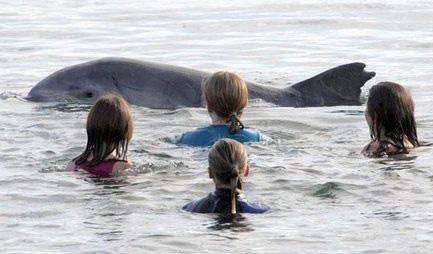
Towards the end of September this year the RNLI Plymouth lifeboat crew responded to a call out from a dismasted yacht. On their return to the station they were accompanied by an exciting and welcome visitor- a lone bottle nose dolphin. He swam along in the bow wave of their boat for around 15 minutes, twirling in the water and very aware of his courteous audience. A short video captured by the crew can be seen here.
On hearing about their playful escort I carried out some research and it seems this dolphin has been doing the rounds in the South West. He has been christened Billy and is easily identifiable by the notch missing from his dorsal fin. As well as Plymouth he has been seen in the shallows of Beer playing with swimmers (pictured above) and as far as Mounts Bay twirling for boats in the harbor.
Billy is not a unique case, this type of behavior has been documented frequently across the globe. Moko a young male took up residence in Mahia beach, New Zealand where his sociability with locals gave him celebrity status. He gained notoriety during the stranding of two pygmy sperm whales in 2008. Exhausted rescuers had been trying for hours without success to guide the whales past a shallow sandbar and back out to sea but despite their efforts the whales kept getting disorientated and repeatedly beaching. Just as the team were contemplating euthanising the animals Moko swam in, approached the whales and led them along the coast line to a channel in the sandbar returning them to the open ocean.
Documentation of Moko’s friendly games are rife on the internet however there are other aspects of lone dolphin behavior to consider. Dolphins are exceptionally inquisitive and playful, people will always be willing participants of this fun but our terrestrial nature means that we can’t permanently remain in the water. As the dolphin grows, their demands tend to follow suit. When Moko was approximately 3 years old he trapped a woman out at sea as he was not happy to end their play session. Eventually exhausted and worried she called out to shore and a boat was sent to her rescue. She later admitted that she had gone out to seek Moko on her own in the early evening for a more personal experience with the ‘tame’ animal and did not blame him for her carelessness.
Worryingly, lone dolphins frequently tend to fall victim to the darker sides of human interaction. In 1994 one such animal named Tiao off the coast of Caraguatatuba, South Brazil became surrounded by a large crowd of bathers all wanting ‘a piece of the fun’. People were seen trying to force feed him treats and the situation escalated when ice cream sticks were inserted into his blow hole. The dolphin was obviously distressed, thrashing and charging at the crowd he left 29 people injured with one later dying in hospital from internal bleeding.
These situations rarely ever culminate in the vilification of those responsible. Despite being the first ever documented case of a dolphin causing the death of a human being, Tiao was instantly branded a ‘killer dolphin’ and mysteriously disappeared shortly after. The much loved Moko was subject to similar behavior when a frustrated canoeist lost patience with his continual play and struck him in the head with her oar. Towards the end of his short life injuries were spotted more and more frequently on Moko and in early 2010 at around 4 years of age he was found dead, the cause of which remains unknown.
Typical dolphin pods constitute 20-40 members, they have a very complex social hierarchy and considerable intelligence and are thought to be able to live to 50. So why do we get such cases where an animal appears to forsake their group? It is thought that their thirst for play is the driving force. A young, immature individual may have a positive encounter with humans and form an association leading to the pursuit of further interactions. In the majority of cases people will always be overjoyed at such experiences and the link between humans and instant play is reinforced.
It is exceptionally hard to recommend how to treat these animals. Moko became very much an ambassador for the species and a great tool for marine conservation campaigns, and in the majority of cases clearly thrived on and relished his chosen companions. However, at the time of his death literature reviews were published stating that of the 30 significant cases of lone dolphins, 14 had ended up injured or mortally wounded by humans.
Despite their apparent choice to socialise with people lone dolphins are still unpredictable wild animals that will not cope will with the pressures of becoming tourist attractions. More importantly humans are still unpredictable wild animals with a propensity to seek ownership of all things. The overwhelmingly unidentified point is that by pursuing these animals we are intruders masking ourselves as guests in their environment, not the other way around.
Note: It is an offense under the UK Wildlife and Countryside Act, 1981 to disturb a wild animal. An example appropriate to this article can be found here.
